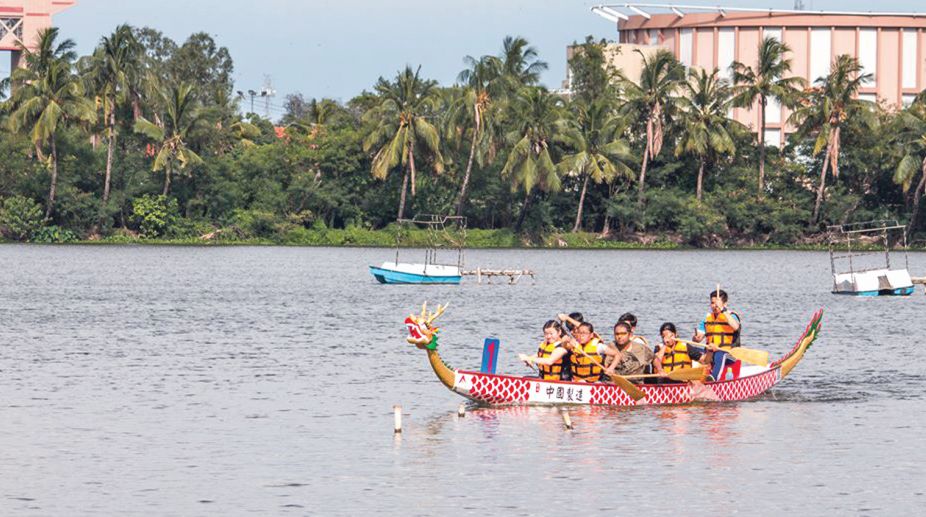Heritage bookstore in College St set to open new outlet
Dasgupta, the well-known heritage bookstore in the city, is going to open its outlet in south Kolkata on 1 May.

DRAGON BOAT RACE IN TANGRA ,LIM GUI SHENG
Chinese
Ever wondered why Kolkata boasts of having the oldest Chinatown in the world outside South East Asia? The hardworking and enterprising Chinese community has vastly influenced the city of Kolkata since the 18th century. It all started with Atchew who bought a sugar factory near Budge Budge and brought Chinese labourers to the capital of the British Empire in India. The place has come to be known as Achipur after him.
Most of the settlers came from Canton, who were mostly a travelling class, earning their bread through family businesses of carpentry, leather tanning and laundry.
With the increase in number, Chinese gradually settled at the centre of Calcutta near a market place designed by Italian architect Edward Tirreta and hence named Territi Bazar.
Once a thriving community of almost 20,000, the number has now dwindled to around 4000 following the large scale migration in recent times. The Chinese community mostly are tannery-owners, sauce manufacturers, restaurateurs, shoe shop owners and dentists. Needless to mention, the restaurants have given rise to an eclectic fusion of Chinese Hakka cuisine with traditional Indian cuisine and is the most popular mark of Chinese influence in the city.
Territi Bazar is famous to this day for its yummy breakfast stalls starting at 6.30 AM selling a wide variety of momos or dumplings stuffed with beef, pork, chicken, seafood or vegetables along with sausages, stuffed buns, pork rolls and wontons. Close by is another iconic store Hap Hing Co, considered to be the oldest shop in Chinatown and selling a wide variety of items from tea, dried fruits, and rice noodles to medicinal herbs. The store even today uses abacus and not calculator and is run by the grand old dame of Chinatown, Stella Chen.
Around the old Chinatown area, are six active Chinese temples. Of them Nam Soon Church dating back to 1820 is the oldest and is especially impressive with a spacious courtyard and intricate décor.
Advertisement
Sea Ip Church established 1905 is another impressive temple dedicated to Kwan Yin, the Chinese goddess of compassion and mercy. Later on, a large section of the Chinese has moved to the eastern part in Tangra, to form the New China Town. In January/February, the community celebrates the Chinese New Year in a traditional way complete with dragon and lion dances on the streets of Tangra &Tiretta Bazar. The entire area is brilliantly illuminated contributing to a carnival like atmosphere thus safeguarding a slice of Kolkata’s unique cultural heritage. Kolkata also hosts and celebrates India’s only Dragon boat race on actual dragon boats brought all the way from China.
Despite dwindling of numbers, the Chinese community continues to be an integral part of the city and is destined to play a vital role in “bridging the communication gap” between the businessmen of the two countries.
Parsis
Parsis have amalgamated into the social fabric of Kolkata just as spoon of sugar dissolves into a cup of milk. One of the world’s oldest extant religions, Zoroasterians from Iran fled the country to avoid religious persecution and reached the shores of Diu and chose to settle in Gujarat areaupon being given shelter by the king in 785AD.
The industrious nature of the Parsis coupled with Kolkata’s exponential growth attracted them to this city from the middle of 18th century. Dadabhai Behramji Banaji of Surat regarded as the first Parsi to be in this city was a shipbuilding pioneer and a close friend of Dwarakanath Tagore. His relative Rustomji Cowasjee Banaji came in early 19th century, and founded a Gothic style Pars near Ezra Street in 1839, which is now completely decrepit and widely encroached upon by hawkers.
The only active fire temple was established in 1912 on Metcalfe Street in Bow bazar area of Central Kolkata and is the major binding force of the approx. 700 strong Parsi community in the city. The Parsis are fire worshippers and the holy flame burns eternally in the second floor open only to believers. The ground floor consists of a large hall containing a brass plate of Faravahar, the Primary Symbol of Zoroastrianism and some beautiful frosted glass work.
Parsis become an important component of the trading network between India, East Asia and Europe and their contribution to trading and business continues to be rich over the decades. The community emerged as a Westernized and progressive one with wide range of opportunities even for females.
The Parsis of Calcutta were once synonymous with a popular fizzy drink (Byron , precursor to Cokes and Pepsis), heavily embroidered silk saris of a particular type, pioneer of the Indian cinema (referring to JF Madan’s theatre empire) and the generous contribution to the charitable trust funds especially during the infamous Bengal Famine. Owner of currently the only restaurant serving authentic Parsidhansak, Patranimachi and other delicacies, Meher Hansotia’s love affair with Kolkata began a decade ago as the manager for the ‘Parsis-only’ guest house ordharmashala bang opposite Bow Barracks.
In Meher’s words, “Kolkata Parsis are very active, sweet, helping and fun loving people. We all participate in lots of activities like community get togethers, picnics, sports, fancy dress, debates, elocution and painting competitions held every year”. Despite the sharp demographic decline in recent times, Parsis have continued to preserve a resplendent heritage and are active in all aspects of civic and national life.
Advertisement